
(Photos: J. Maus/BikePortland)
You probably didn’t even notice, but I just returned from 17 days in France and Amsterdam.
Even though I wasn’t working, I managed to snap a few photos of wonky street scenes, bicycles, and the people who ride them.
I’ll share photos and a few thoughts from my time in Paris in a separate post. Today let’s take a look at what I saw in Amsterdam.
As some of you might recall, I did a study trip in Amsterdam (and elsewhere) in 2013. This time around was much different. Juli (my wife) and I were there simply as tourists — to soak up as much of the local culture as we could and enjoy the quirks that make Amsterdam many peoples’ favorite city in the world. We strolled along narrow, canal-lined streets and visited museums, shops, and charming cafés. And guess what? We never set foot on a pedal. Instead, we opted to walk everywhere.
The decision to walk saved us a few Euros and enabled us to wander seamlessly — safely out of the infamously fast-flowing river of Amsterdam bike traffic. (Being on foot also helped me realize that in a city where bicycling dominates, walking suffers.)
For simplicity’s sake, I’ve put my images into three broad categories: people, places, and things.
People
I could sit in a café and watch people on bikes in Amsterdam all day. Compared to what I see in Portland, the diversity (in age, race, and class) of riders and skill they demonstrate is remarkable.
Teens just out of school roll by in groups, continuing the same conversations they had in class (it’s very quiet in Amsterdam because there are so few cars); people calmy carry all types of objects (including babies and small children) that would evoke stares or even rebukes in Portland; many people use their phones while biking; older people maintain their independence and freedom of movement thanks to bicycling; lots of business — from the mail to freight delivery — gets done by bike; and they do it all while looking very fashionable (this is Europe after all).
Advertisement
Places
Walking around the streets of Amsterdam is like being a kid in a candy store. Narrow streets are all but given over fully to bicycling and/or walking and wider streets have cross-sections that transportation refomers in the U.S. can only dream about. I can’t recall any places where drivers dominate. And even when cars are present, the speeds are very low and it’s understood that people on bikes and foot have priority.
With so few cars, Amsterdam is probably the quietest big city in the world. And without the need to facilitate parking or driving of automobiles, street markets flourish throughout the city.
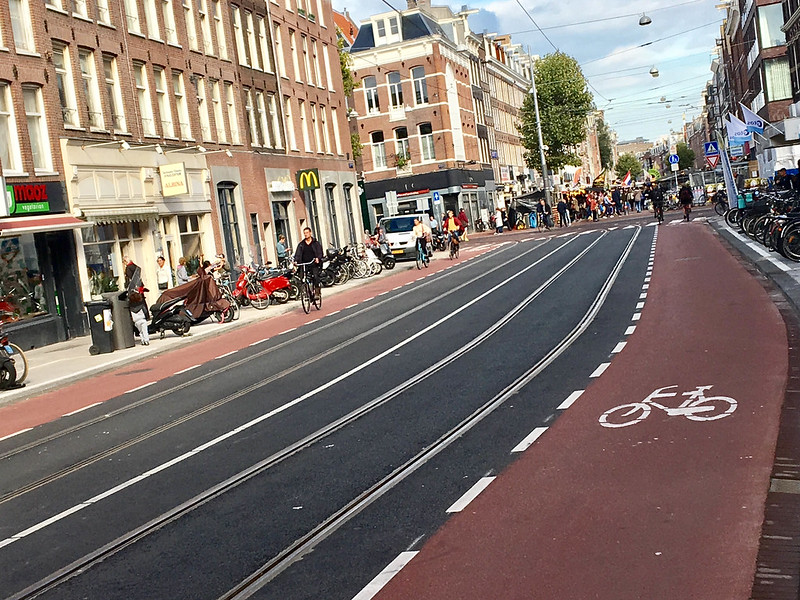

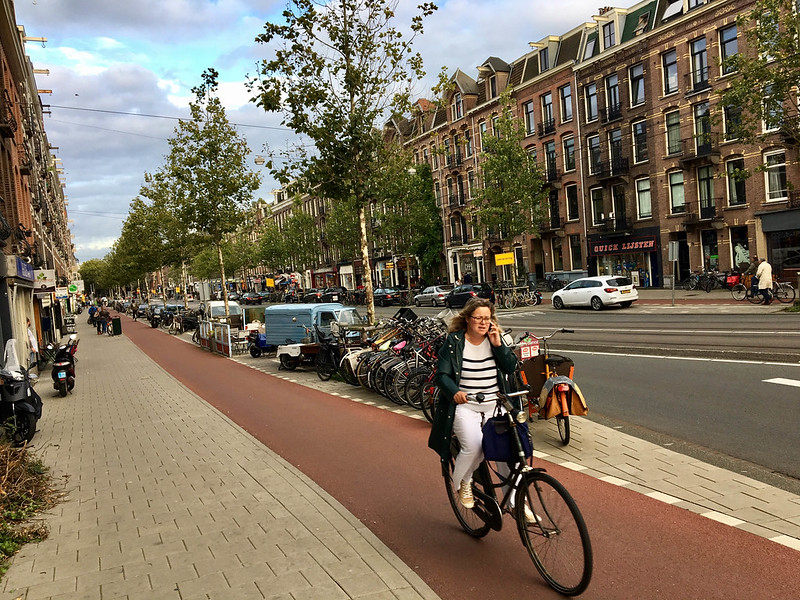
I was fascinated by Utrechtsestraat in the Amstelveld neighborhood. A busy shopping street with many modes (freight, bike, walk, transit) and with almost no markings or dedicated infrastructure, everyone managed to use the road safely and efficiently…
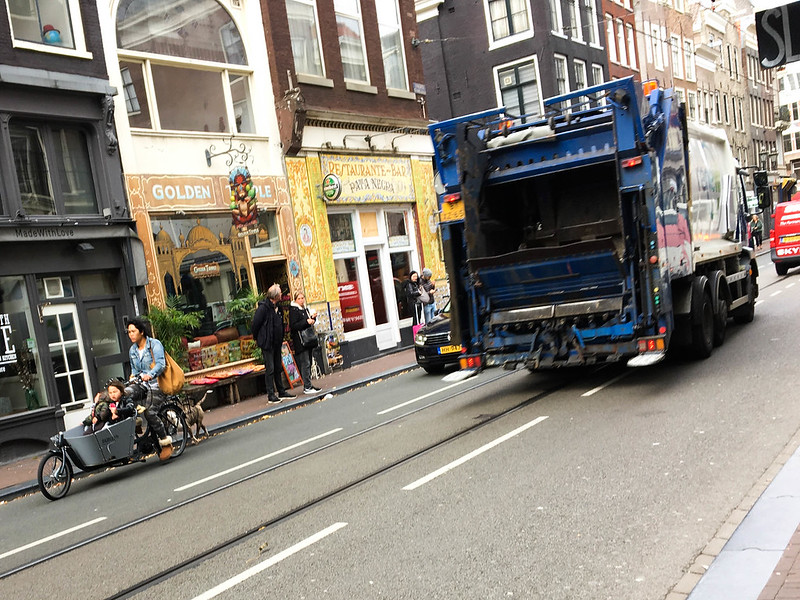
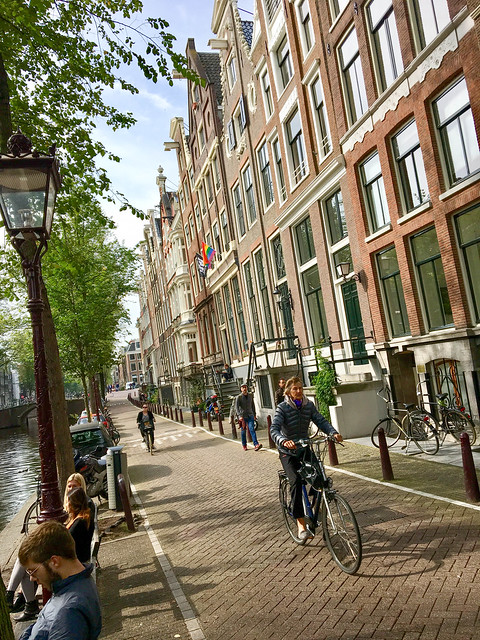
Typically picturesque street along a canal.
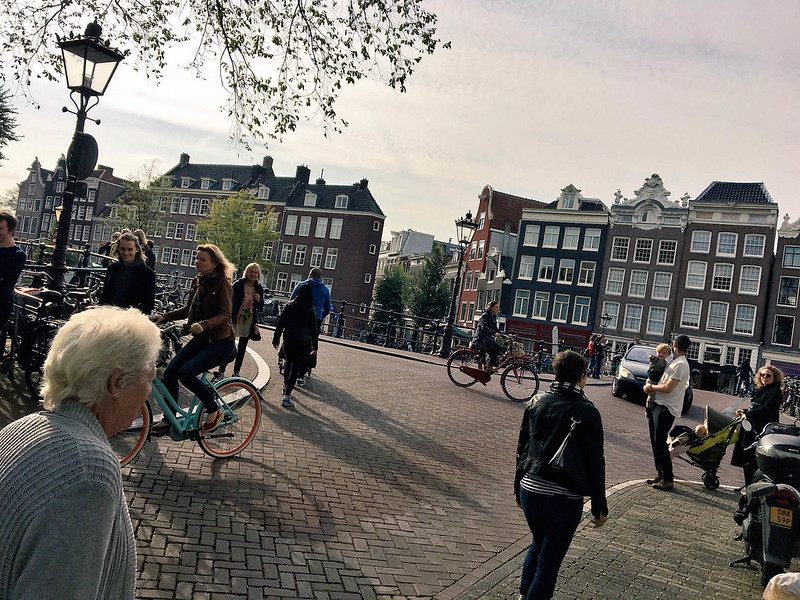
Things
#Amsterdam takes bikeway cleanliness very seriously. pic.twitter.com/lsKA5jyhF3
— BikePortland (@BikePortland) October 5, 2017
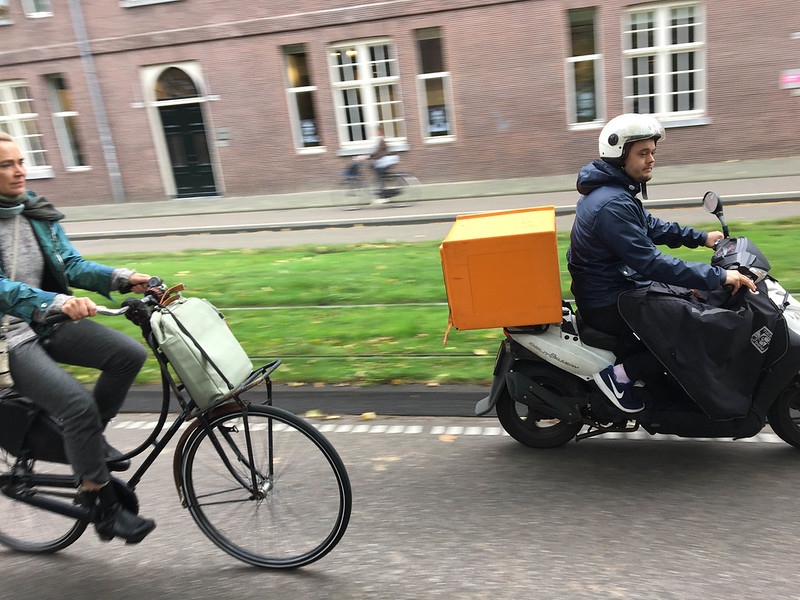
And finally… We really need these in Portland!
Stay tuned for a few photos and thoughts from my week walking around Paris.
— Jonathan Maus: (503) 706-8804, @jonathan_maus on Twitter and jonathan@bikeportland.org
Never miss a story. Sign-up for the daily BP Headlines email.
BikePortland needs your support.


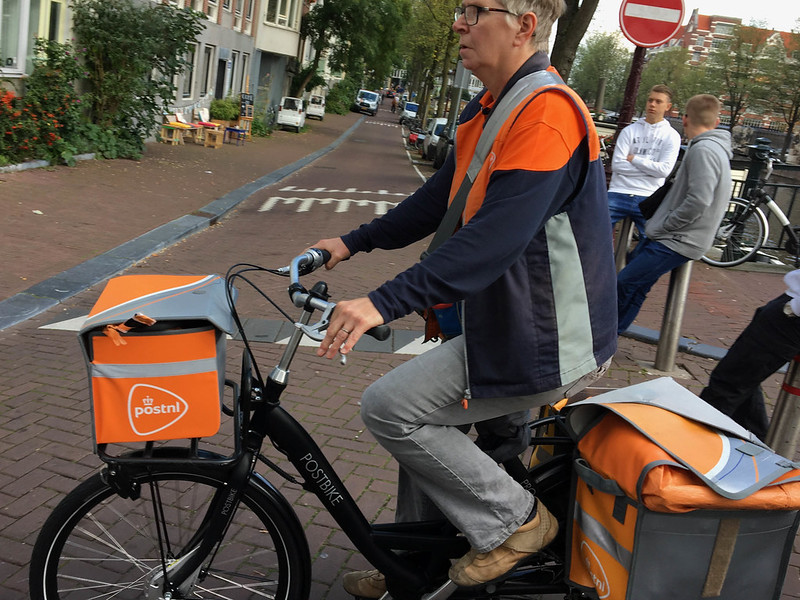

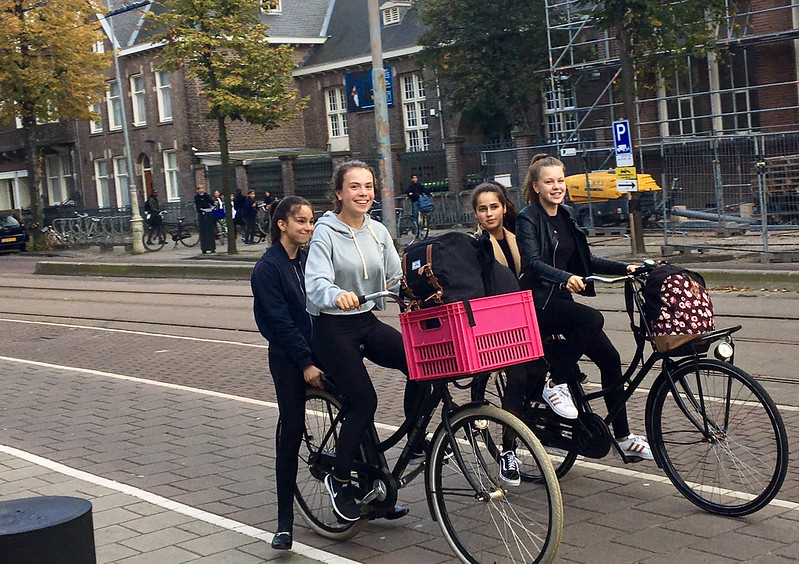

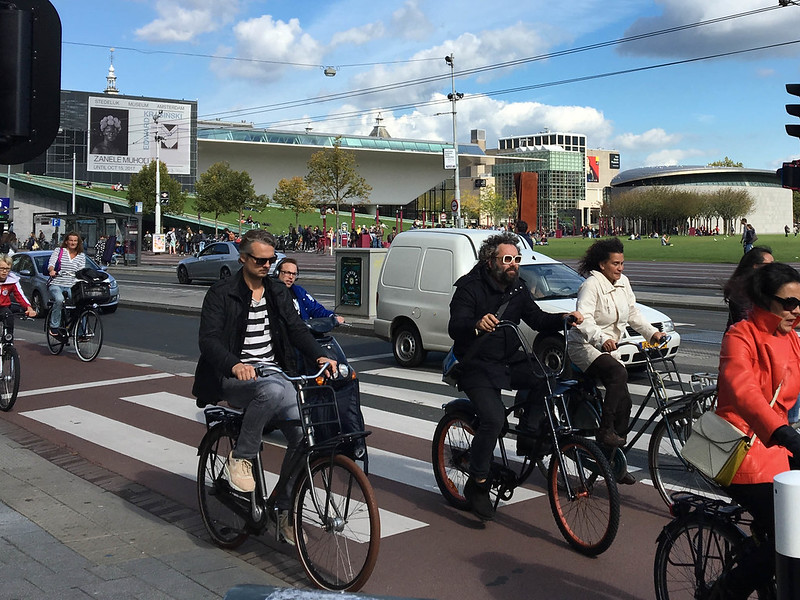
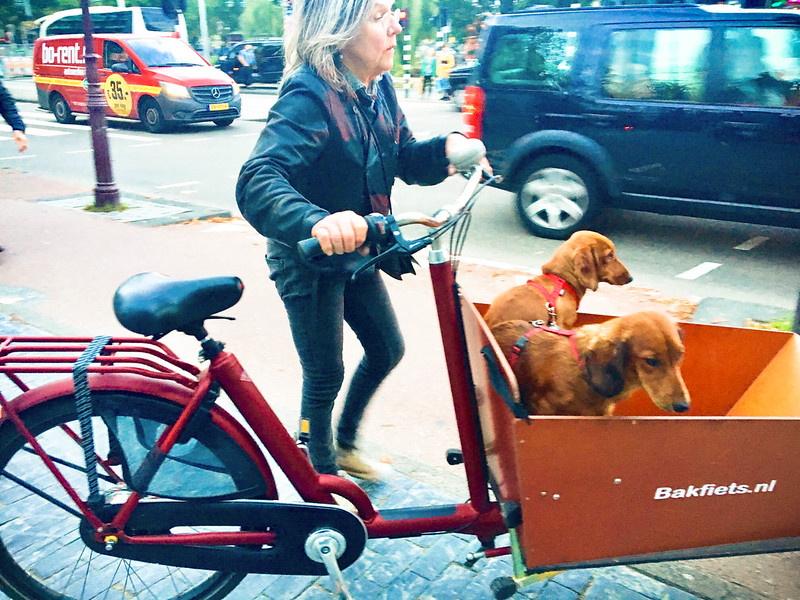
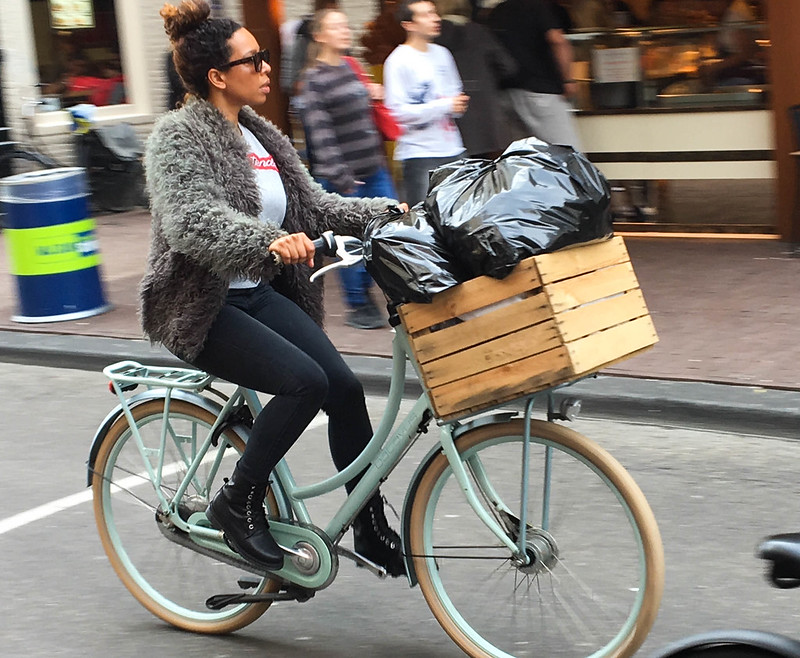
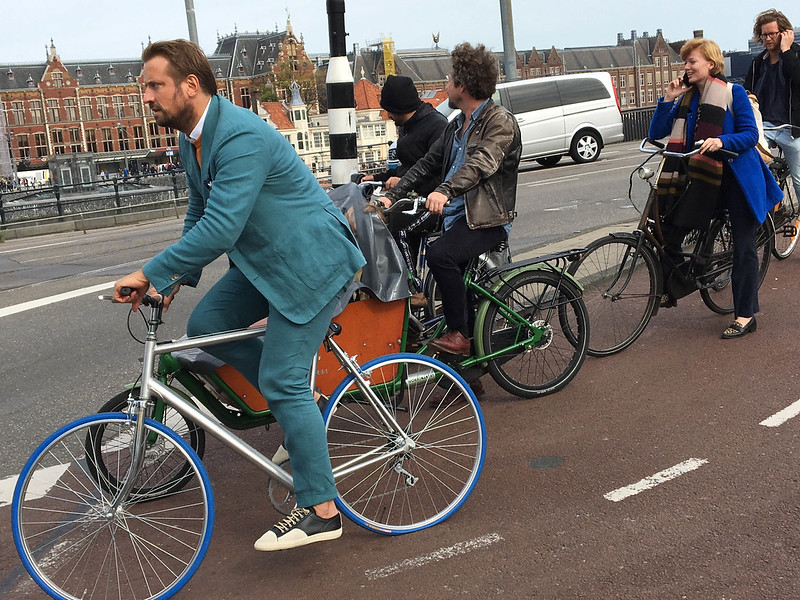
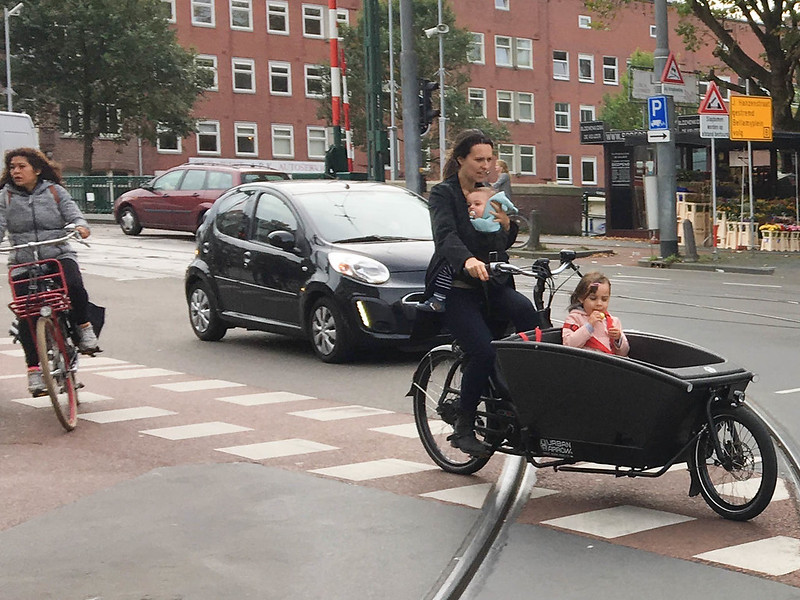
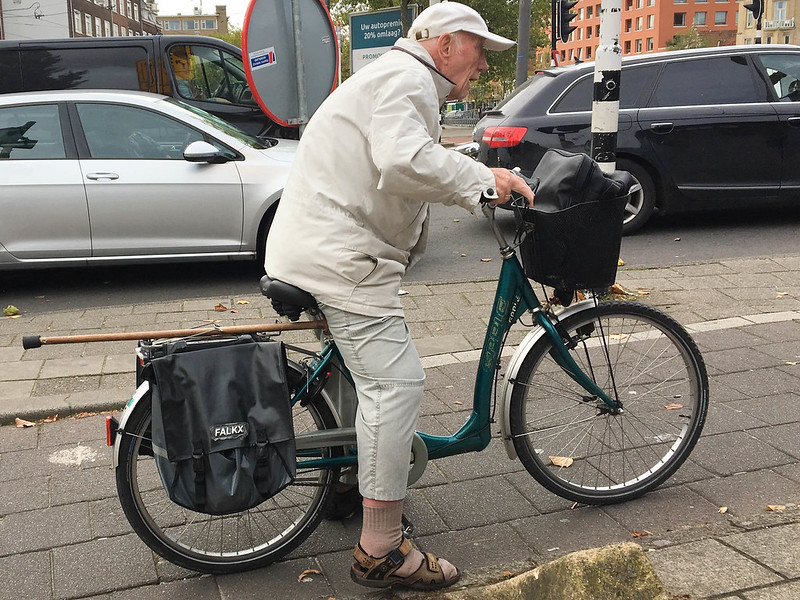
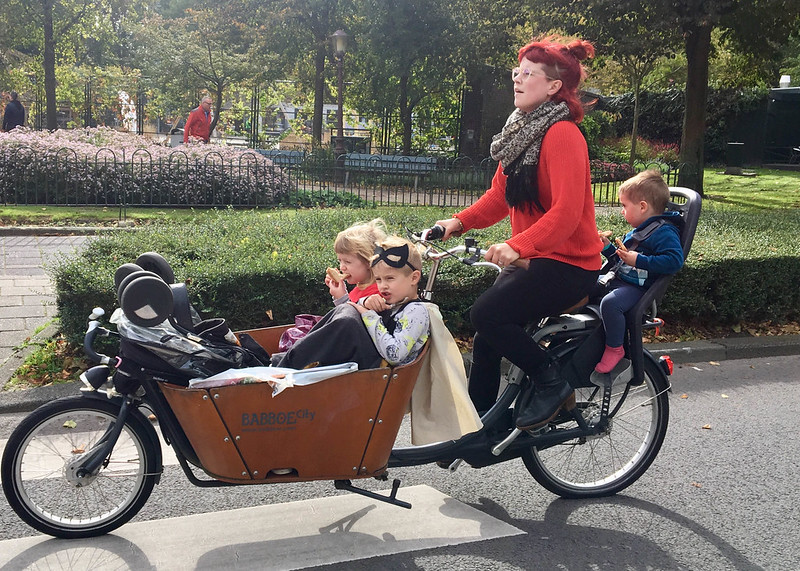

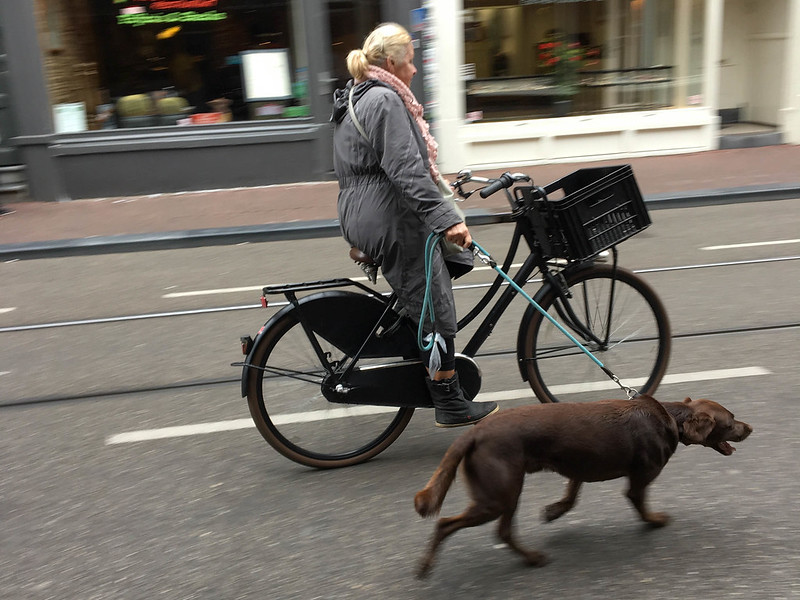
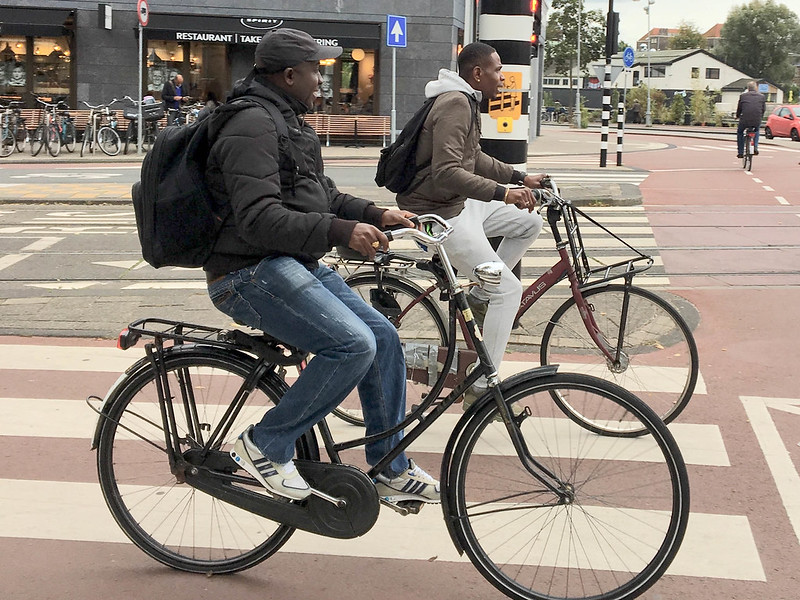
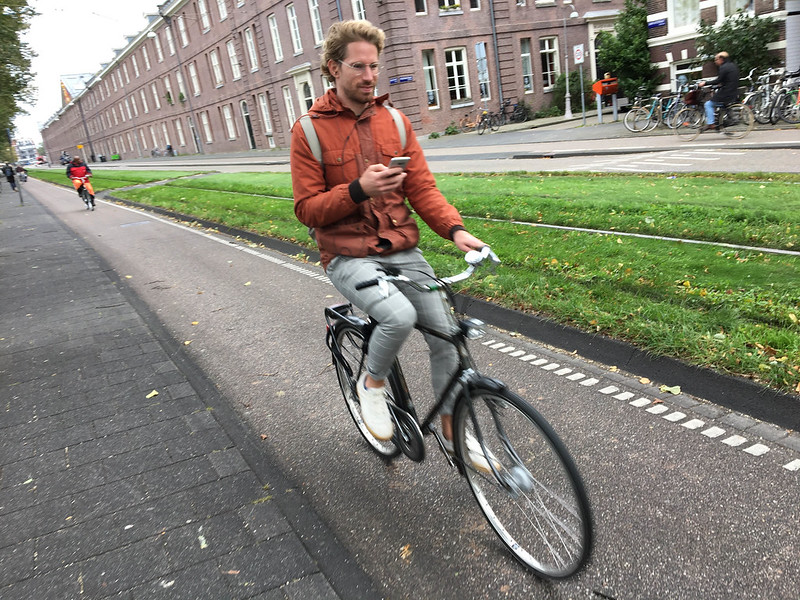
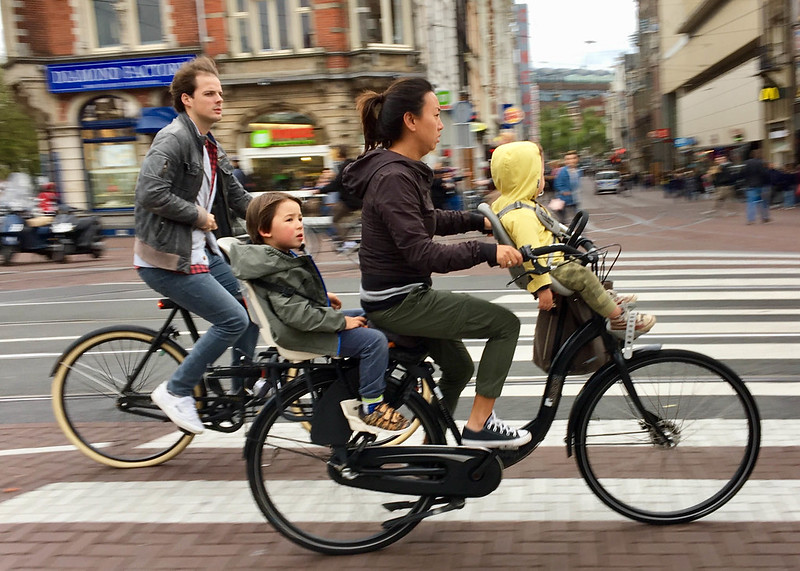
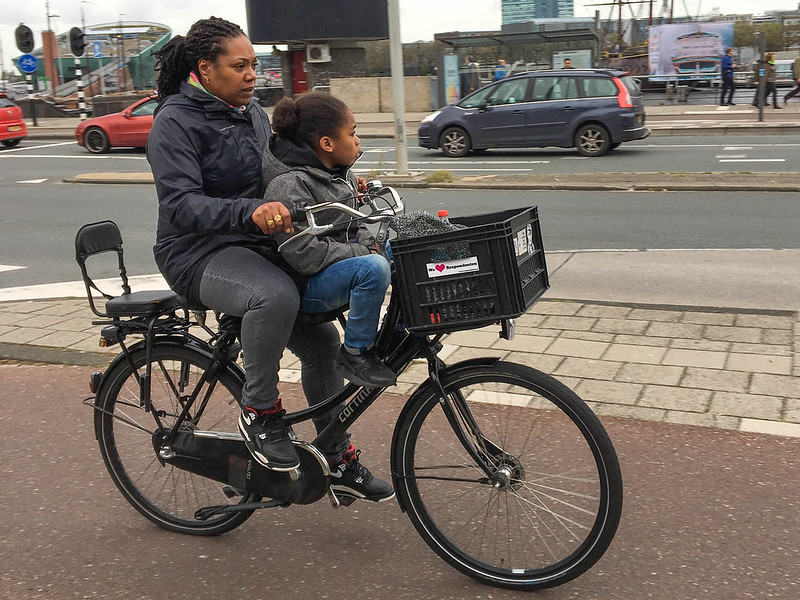
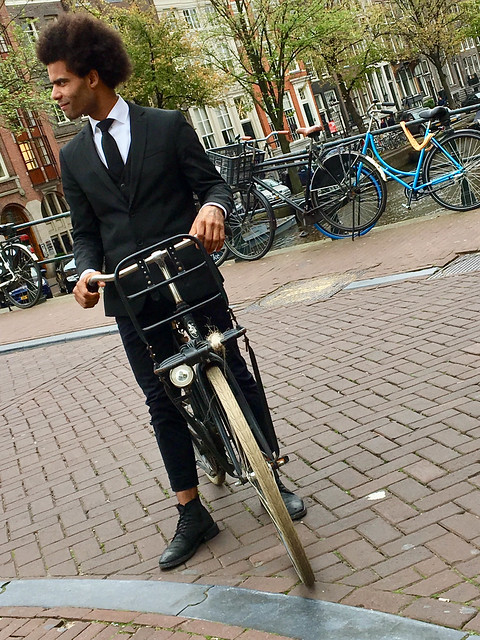
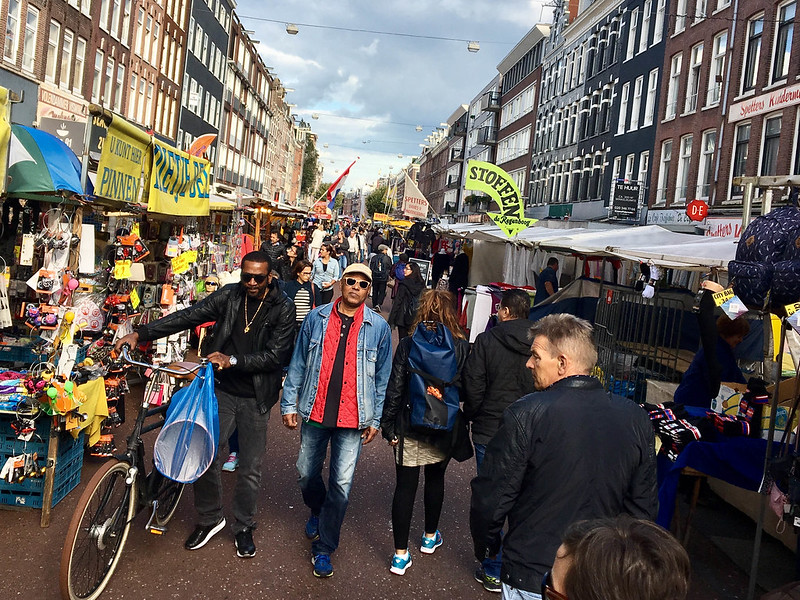

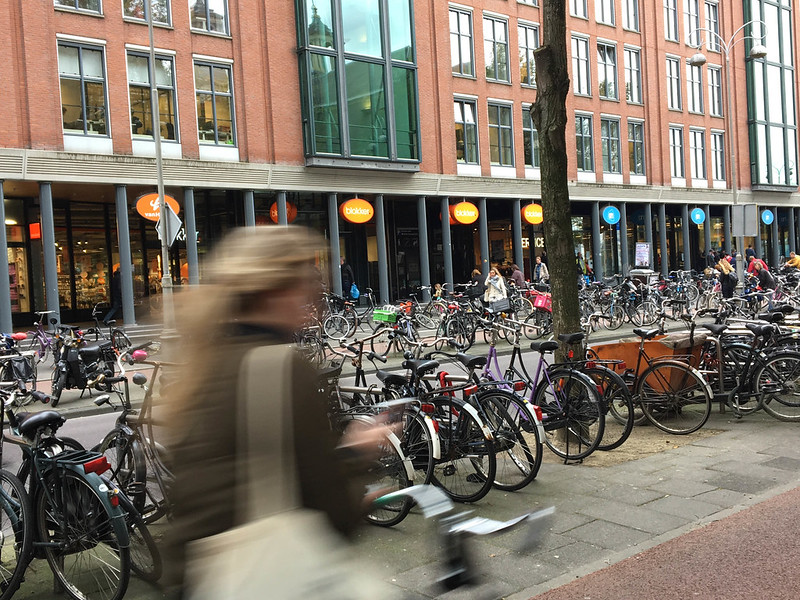


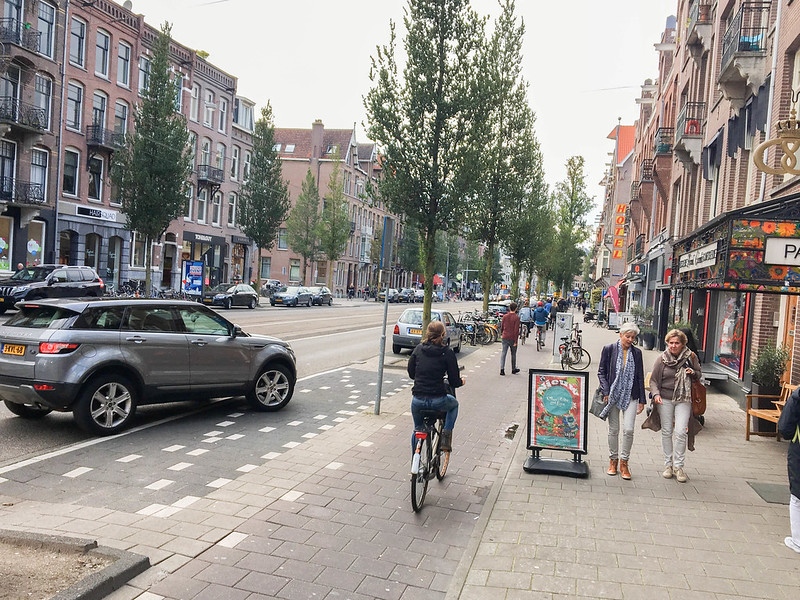
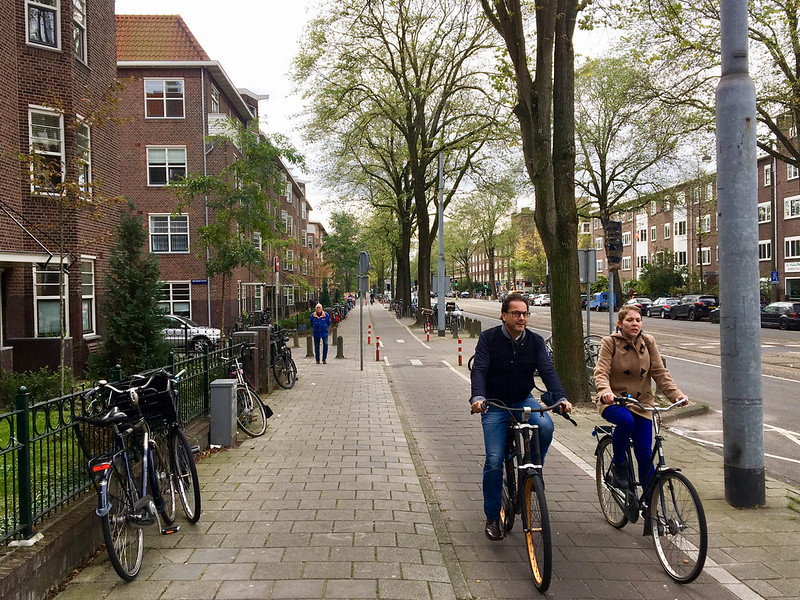
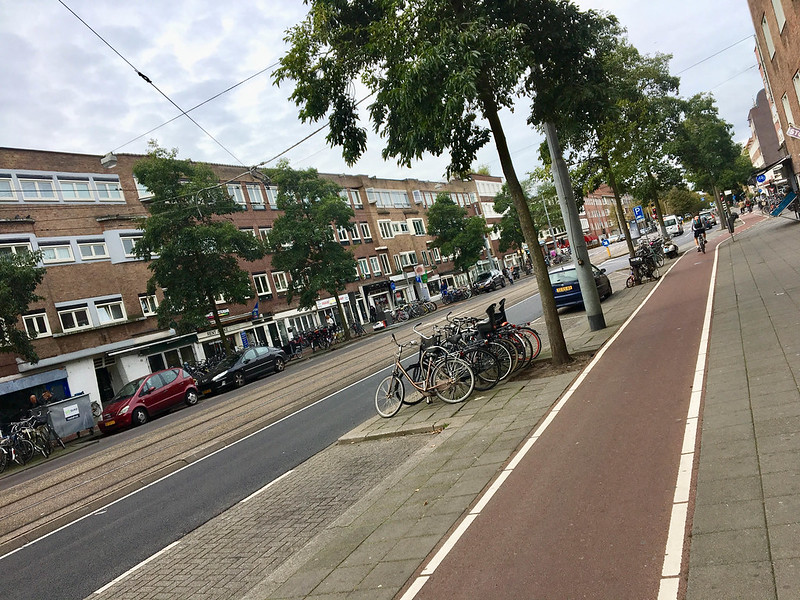
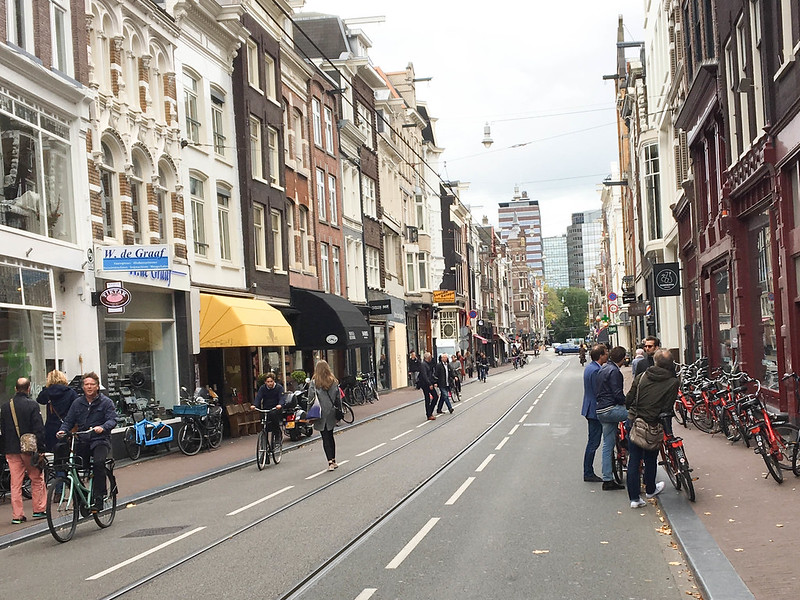
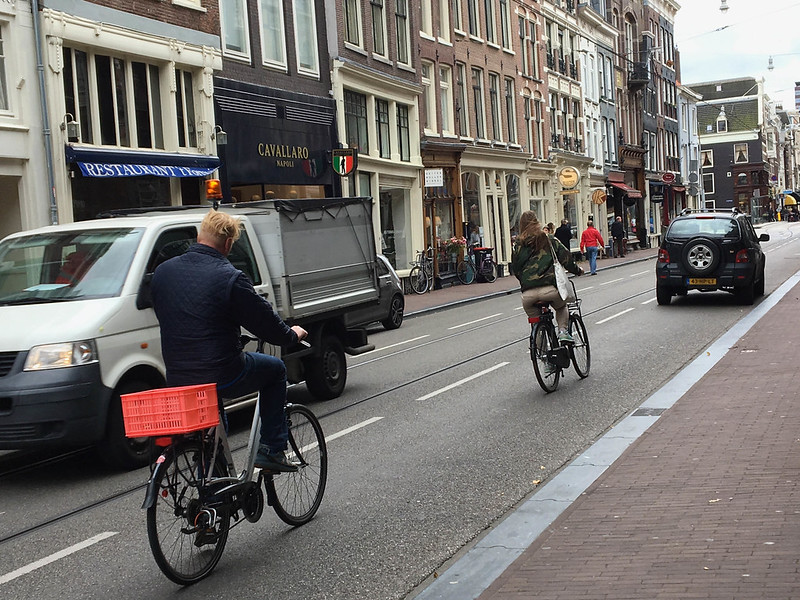
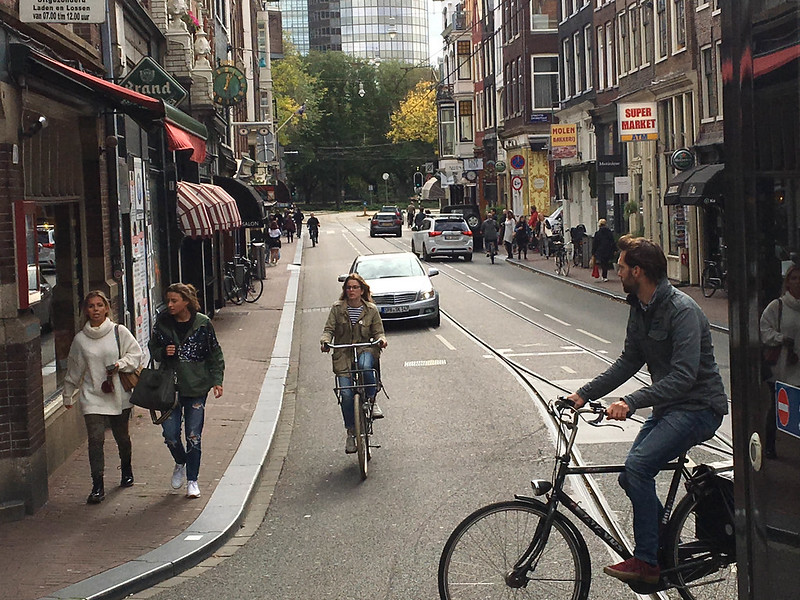

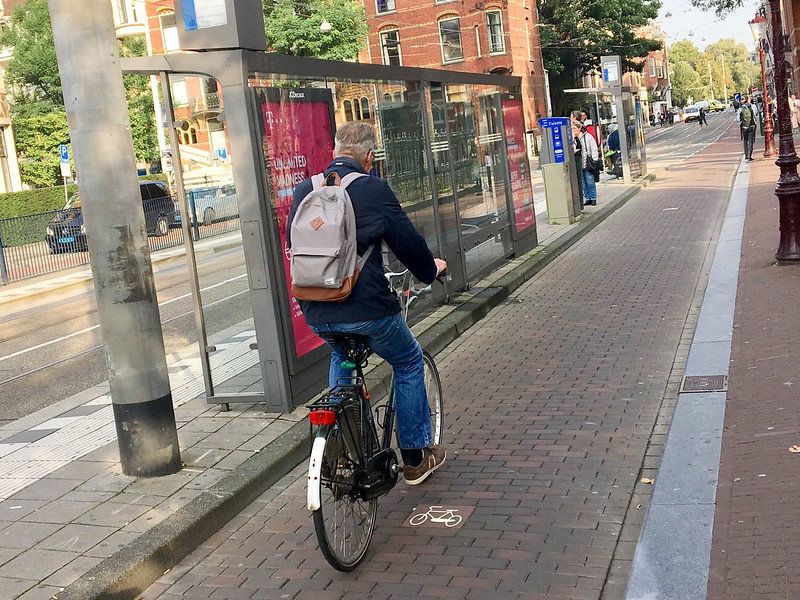


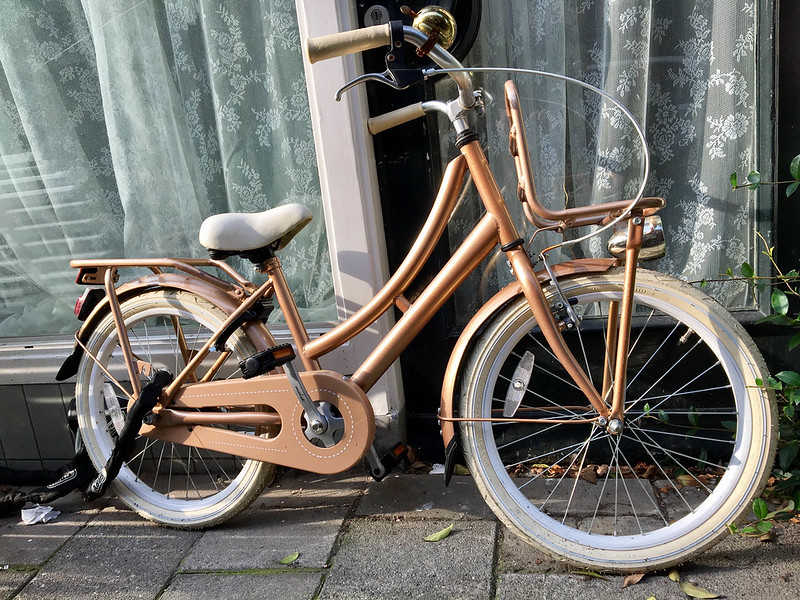
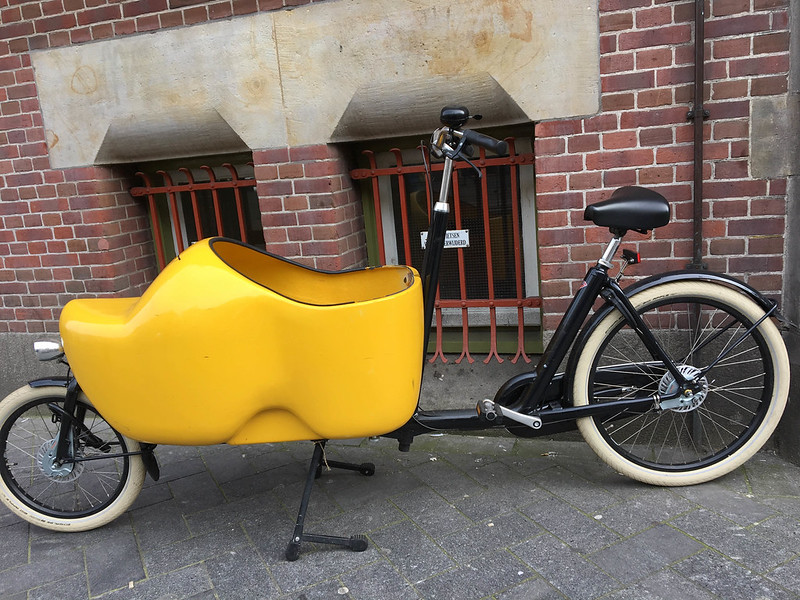


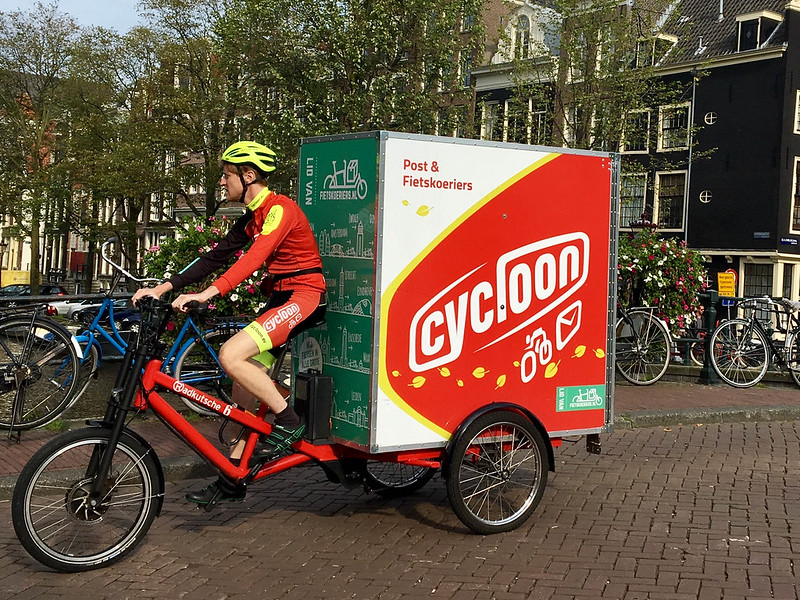

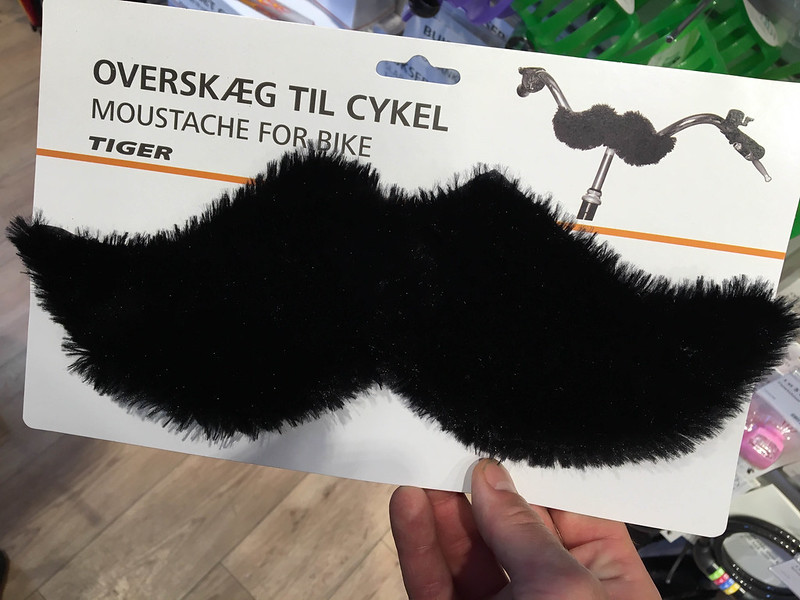




Thanks for reading.
BikePortland has served this community with independent community journalism since 2005. We rely on subscriptions from readers like you to survive. Your financial support is vital in keeping this valuable resource alive and well.
Please subscribe today to strengthen and expand our work.
Jonathan – thanks for sharing! Yes, glad your trip included time to sit back and see how all the day to day issues of a city have been reformed to fit into a smaller urbane footprint…like trash, street cleaning and home delivery. My nephew may have been one of the food delivery bikers you saw jetting around the heart of Amsterdam.
Welcome home, and thanks for the photos. Your fill-in colleagues did great, but it’s good to see your byline again.
Welcome home! 🙂
Here are a couple of random pics from NL/AMS this summer. I might have to do a post or two also.
Great pics Ted! Especially love the panniers-as-planter boxes one.
The overhead drone angle is really neat.
Ted we went to the trouble of finding the Ring and stayed in a horrible hotel in the bottom right corner of your photo. Its definitely built for the future, that area is not fully built out yet. Thats something we don’t do well here, plan ahead and build infrastructure before you have to try to squeeze it in after the fact. Thats one benefit of having an all powerful Central Government!
Definitely a commercial/industrial area. I stayed quite a ways away from there. The ‘ring makes sense but it is a little out of place.
The mopeds in the bikeways were probably the only thing that really irked me in Amsterdam.
There was recently a demonstration to remove them from the lanes. It is strange.
I’m curious whether the problem is speed, noise, or a combination/other? Is there a similar problem with electric bikes? We get a lot of friction from speed mis-match but our bike lanes and paths (generally the biggest problem) are far too narrow.
Read Jonathan’s link. Protestors say air quality and speed concerns. In practice there are cultural issues as well from what I saw. People who ride scooters are younger and are folks who live further out (farther commute) but are not using buses/trains, and honestly a large percentage of scooter users are newer immigrants. They ride with passengers and want to pass the bikes. Bike lane is often only 6′- 7′ with wide handlebars and curbs on either side. Passing at high speed is dicey.
here’s a complaint sticker seen there.

Definitely partly a cultural issue- I’ve read that immigrant males often feel that bicycles are “beneath” them.
Primarily speed and behavior. Several of them passed us going about 20mph+ (which is a big speed mismatch from normal speeds in AMS) and they were just a few inches from my left hand.
Some of it has to do with the fact that they use gas engines, as well. Pollution, noise, etc. They shouldn’t be able to use bike infrastructure.
Great shots John! A-dam an amazing city, its people and a great walk too, just be careful… nice shot of the wooden shoe work bike–among others… Your comment, “I could sit in a café and watch people on bikes in Amsterdam all day.” Pete Jordan in “The City of Bikes” also shared a similar observation.
Love the Heineken shot.
Great post, John! Glad you enjoyed Amsterdam 🙂 Did you have a chance to see other Dutch cities? Amsterdam is far and wide one of the more chaotic and busy cities, largely because of all the tourists but also since, despite being a cycling haven, it doesn’t restrict cars nearly as much as other Dutch cities. It can be especially annoying to walk along the narrow canal streets where the sidewalk is barely wide enough for 2 people. Yet you have a full lane for cars/bikes and then a parking lane next to that against canal. If one of those would even be partly converted into a sidewalk, it would already be a huge improvement. And because these streets are so narrow and sometimes busy with traffic, you are also not legally allowed to cycle contraflow, which is very much more the exception than the rule in this country. I haven’t visited all the cities yet, but some very nice ones that I can recommend to anyone include: Utrecht, Maastricht, Den Bosch, Breda, Middelburg, Nijmegen, Bergen op zoom, Alkmaar and Goes.
I notices in Amsterdam there were streets with 80% of the traffic was on bikes restricted to 20% of the road, so the remaining 20% could use 80% of the road for cars.
Its not just in Amsterdam but all over Netherlands; earlier this year my husband and I went to Scheveningen which is beach area part of The Hague and the road layouts were very similar but with a little more space. You had pavement,cycle lane, 2
sets of tram tracks, 2 lane road and pavement. At the beach there was large areas for bikes and about 12 parking spaces.
Nice to see so many helmetless riders. Still can’t understand America’s obsession with those nuisance, uncomfortable, essentially useless appendages. I’ve been riding for over 60 years and have never had one.
Yeah I really regretted wearing a helmet when my head hit the ground on a wet day crash.
Fine, it’s a personal choice; just don’t proselytize to the rest of us.
Yeah, I hate it when someone recommends things that might keep me safe, like helmets or seatbelts. Really annoying
I’d prefer we devote more energy to practices that will keep other people safe. Seatbelts, helmets, climbing harnesses, orange vests….these are individual safety items, and if you don’t want to wear them, it’s not endangering my life in any way.
Yes and no for climbing harnesses. Free climbers can injure or kill people climbing below them on multi-pitch routes, and have done so in the past. I have had to stop my progress on several climbs while getting passed by free climbers, because I don’t want to be in their fall path.
Fair enough, forget the climbing harness example.
Point being, we are already completely overwhelmed with the prospect of getting people to drive appropriate speeds, watch where they are going, and stop crashing into things. Helmets and seatbelts, while important to the people they protect, are a distraction from things that would make the world safer for others.
I sometimes ride around my neighborhood without a helmet, or drive around the neighborhood without my seatbelt on. This doesn’t endanger others in any way. It is not the same thing as the parents I see speeding in their cars on the way to school while talking on their phones.
It’s much easier and cheap to promote helmets than to build or modify infrastructure. Theoretically it doesn’t even cost anything (aside from PR, etc.) because it’s up to the individual to purchase one, and it’s then up to cyclists to keep themselves safe rather than having to make the cycling environment more safe. The bigger issue I have with this is when it too often puts the onus on the victim, as if drivers are more likely to crash into you when you aren’t wearing one.
I’ve just gotten into a back and forth discussion about helmets in another recent blog post, but in the case of the northern European countries, it mainly comes down to level of helmet promotion. The two most bike friendly countries are the Netherlands and Denmark. Up until 10 or so years ago, helmet usage was still extremely low in both. The Danish government and cycling union chose to heavily push people to wear one since 2008 while the Dutch government and cycling union to this day largely avoid discussing safety matters or promote helmets publicly. In the Netherlands, helmet usage is still well under 1%. In Denmark, it’s now officially 35%. http://www.cycling-embassy.dk/facts-about-cycling-in-denmark/statistics/
It’s not about infrastructure. It’s about a totally different type of riding.
Helmets provide much less potential benefit for low speeds you can match on foot than longer and faster rides.
If the only way I could ride was on paths like that, I would quit unless there was no alternative. It would take too long and it would neither be fun nor exercise to me.
I’ve been in two crashes where my helmet came in useful. In one of them, I was knocked out even wearing it. I wouldn’t want to know how that would have worked out without the helmet.
I see your point in general. Yes, it’s a different type of riding oftentimes. After all, we’re talking about the entire demographics of a whole nation cycling to get around. But to bike in a Dutch city does not necessarily mean that you can only go slow, or below 12 MPH. It depends where and when. Some paths are wide and straight even in the city center and are perfect for scooters to blast through at 30, 40 MPH speeds without any issues. Other paths are more narrow and/or full of other cyclists which will obviously slow things down for everyone. There are quite a lot of recreational cyclists in the Netherlands as well, and the ones on road bikes are even called something different (Wielrenner). Obviously, they try to avoid city streets where they can’t go as fast as they want.
This is not directed at you per se, but I just wanted to dispel the generalization that I often hear from people in the States, that all Dutch and Danish cyclists are slow, that you can only go slow in the cities and that separated cycle paths necessarily mean you cannot go fast. It really just depends. Most people here do ride at a leisurely pace. I myself ride between 12-17 MPH on my 3-speed Dutch step-though bicycle. Sometimes, there are teenagers on similar bikes that pass me while going quite a lot faster than that, and people who have more hybrid-like bikes are usually faster as well. The elderly people with e-bikes almost always go faster than that, and it goes without saying for racing cyclists. The average speed of cycling in the Netherlands overall is very slow, but we need to keep things in perspective and remember that it’s largely because the entire demographic cycles in that country.
There are a number of factors that don’t make helmets essential in Amsterdam. First, the traffic, including bicycles, is moving slowly, so any impact is likely to have substantially lower force. Secondly, there are so few cars that a collision between a fast moving car and a bicycle is lower, therefore the risk is lower.
I have had a bike incident where I impacted the ground with sufficient force to fracture my humerus, but I was riding a road bike at a pretty good clip, around a corner and hit gravel – I don’t think I hit my head, but I tossed my helmet anyway. None of the people in the photographs above were riding road bikes – they were riding what we would call “Dutch” bikes, upright, comparatively heavy, slow bikes, in heavy bike traffic – there’s not much scope for incurring a serious head injury from a high speed fall/collision.
In contrast, in Portland, we’re sharing the road with motor vehicles traveling at least 25 mph (40 kmph), some of those drivers are drunk, high, distracted, speeding or otherwise ignoring the road code. Many of us are riding road bikes capable of traveling at significantly higher speeds (I average 15 mph on my 20 mile commute between Clackamas and North Portland), so the chances of sustaining a serious head injury are exponentially greater. I would be okay riding without a helmet in Amsterdam, in Portland or Seattle not so much.
I’ve got some bad news for you. In a collision with a car, your helmet is nearly useless. It’s primary benefit is when you crash all by yourself.
Think of a helmet like you would think of the styrofoam packaging for a computer. It’s great if the box, or head, is dropped from a low height to prevent damage to the computer, or brain. However, if the delivery truck drives over it, the computer is going to be toast, as is your head.
It’s just plastic-coated styrofoam. It’s not going to leap tall buildings, bend steel or prevent damage when impacted by several tons traveling at many tens of miles per hour.
I still think helmets are vaccines against traffic fatalities. Why else would the media report that a bicyclist was not wearing a helmet in every fatal accident story? They might as well add a disapproving mom wagging a finger gif to those paragraphs.
Anyway, these are exactly the fantastic pics for which I was waiting when Jonathan returned. Thank you.
But, the vast majority of cycle crashes do not involve contact with a motor vehicle. I have broken two helmets, but no heads, without ever coming in contact with a motor vehicle.
and i have crashed over a dozen times at high speeds (>20 mph) and have never once even scratched a helmet.
anecdotes literally have no significance.
Correct, observing that your own experience is anecdotal.
Facts and research are relevant. There is no question that helmets can mitigate many head injuries nor is there any question that head injuries contribute to many serious injuries and deaths in cyclists.
Whether a helmet helps in a particular crash is all about crash dynamics. Your head is unlikely to get hit hard in any kind crash where you wind up sliding and getting a case of road rash. Endos, front wheel washouts on super slick surfaces, and other impact crashes — particularly when your head is leading the way. Certain types of bikes and riding will correlate with different types of crashes.
It’s not a good idea to exaggerate the effectiveness of helmets, pretending they don’t help is one of the reasons why so many people don’t take cyclists seriously. And why would they?
the internet opinions of trolls are not “facts”, kyle.
Agreed, though I’m curious why you’d call out your strategy in this way.
You might consult the CPSC data regarding head injuries and cycling incidents. It’s hardly the only information on the matter.
another unsupported claim on the internet!
I was witness to a car/cyclist crash over here in SE last Thursday. The woman who was hit was badly injured and her helmet was destroyed. I’d love to not wear a helmet, but you know, crazy shit happens and it’s cheap insurance.
I wear a helmet while riding my road bike because I will routinely travel 15-20 mph and over my life have had 2 instances where braking to avoid scofflaw cars put me over my handle bars with my helmet hitting the ground fairly hard.
When I ride biketown in a position very similar to the riders pictured, I am very happy to not wear a helmet.
I think helmet use, like many mindsets of us ‘Murican cyclists, have to do with existing in often-hostile space. If I lived in Amsterdam, I might just believe that drivers are human beings too.
“A bikeway that’s sett in stone”
fixed that to make the pun obvious…
Cool photographs, Jonathan!
“Amsterdam is probably the quietest big city in the world”
I recommend Helsinki if you want really quiet
I see a lot of street car tracks on those streets. How do the bikes interact with those tracks? Are they narrower and less grabby than the street car ones here in Portland? (I admit I’ve ridden over MAX tracks much more often than street car tracks, so maybe the ones we have here aren’t that bad either.)
The Tracks in Amsterdam and also in some UK cities are set into the road and when you cycle or even walk across them there is no problem. this youtube vid shows trams and others getting on their day. I’ve put it to start at point where you can see some people walking over the tracks and some on bikes just after. https://youtu.be/LMHDV1pwr4Q?t=39s
Being set into the road does not eliminate the danger of crossing tracks improperly with a bicycle. (dropping a wheel into it) In fact foreign tourists not used to utility cycling are often snared by them. I’ve witnessed more than one there. Ever courteous citizens rush to the aid of the hapless tourist and set them upright again. Why doesn’t this happen to the locals? Difference is the Dutch are superbly endowed with bike skills from infancy and one of the most basic is crossing tracks properly.
I won’t win any friends here when I profess little sympathy with bikeportland comments expressing outrage at tracks in our city and how grossly unfair and dangerous they are to cyclists. The complaints are more a reflection of a lack of core competency in bike use, and this includes many who see themselves as accomplished. There’s little excuse for not being able to negotiate tracks if you’re a city cyclist, including even tracks running parallel to direction. This might sound like blaming the victim but it’s more a call to take maybe 10 minutes on a little used track intersection somewhere and practice crossing as close to perpendicular as necessary till it can be done with little to no thought. Not rocket science. Remember; rubber side down 😉
Love the pictures. I think Amsterdam is a perfect example of what can be accomplished by making the use of cars expensive and inconvenient.
Coincidentally, I ran across this the other day.
http://mashable.com/2017/09/30/streets-of-amsterdam/#xCV69n_s.OqE
Funny to read how you are looking at us….. but there’s more to our country and riding a bike than Amsterdam. Next time visit Deventer or Nijmegen or Utrecht. You’ll be suprised.
Greetings, a dutch traffic engineer
Street of your dreams had some very scrawny, unhealthy looking, small trees. Portland is moving that direction also – treeless (or small, sick trees) urban density!
Get involved with your local Friends of Trees group, if you’re not already!
The areas of the city with the lowest amount of tree coverage are actually fairly low density sprawling neighborhoods on east side. Many of the denser neighborhoods close-in have very mature canopies, and a few multi-story buildings here and there aren’t going to make a measurable difference. If we want more trees in Portland, we need to plant more in the fringe neighborhoods.
Amsterdam seriously looks like cycling-as-transportation heaven. A stylish heaven.
Dankjewel Jonathan! My favorite place to be, the place I’ve spent more time than anywhere else. Also visit Den Haag, very civilized, as another said, a bit calmer, easier to draw parallels to here because there is a good amount of car traffic. I hadn’t thought about it as quiet before but you are right. The scooter controversy was extremely interesting to me to watch last Summer as we rode (with our bike competent teenagers) around Amsterdam and Den Haag. A real crisis point in my mind brewing there because the entire system depends on TRUST. Everyone knows the rules, and (exhibit: your pic of mom w/kids and dogs passing major truck) TRUSTS others are paying attention. That is the main difference from here. We don’t trust anyone…with good reason. Without trust of rule following there every intersection and every crossing would come to a screeching halt. Thats the sure sign of a tourist, they stop in an intersection, not trusting those passing around them. You have to trust that everyone else is competent and move ahead. Its hard for Americans to even comprehend putting that kind of trust in their fellow Portlanders. We are eons away….and it starts with teaching kids, teaching ALL kids and people following the laws for the greater good, not being selfish cowboys. I witnessed Omas yelling at young (presumably immigrant) people on scooters for running lights. The entire thing magnificent system is at risk.
I could go on as this is a subject I’ve observed for many years and am fascinated by, but thank you for the great pics. And helmet comments? Alstublieft Portland! Don’t be so damn predictable ; )
When I bike tour in Europe, I notice there is a lot of infrastructure for bikes, but much of it is not very good. Bike lanes and roads are often cobble stones. We joke, look cobble stones, must be the bike route. 30% grade and cobblestones aren’t just for classic riders, its the bike path. In Munich, the off street bike paths are often unpaved and muddy. Rural roads in Bavaria often have side farm and bike roads, but these roads can end at any time putting you in a muddy field or on a shoulderless busy road. However, drivers are different, they know how to pass and wait when they need to.
Amsterdam has gone to most roads having no lane markings, signs, or traffic signals. Bikes, scooters, kids cars and most everything else appears to move by some social choreography that I don’t understand. The tourists on bikes don’t understand it either and are a bit of a problem. Not sure the same would work in Germany or the US where everyone wants everyone else to follow the rules.
the technical term for this is bicycular cycling.
i strongly recommend that people who “drive their bikes” or pedal their “vehicles” give this a try! i also very strongly recommend that drivers and “pedestrians” whose end point is a car interior give this a try!
It’s interesting to see how jarring it is to see people riding bikes that aren’t just not wearing helmets (as has been mentioned several times) but also not wearing special clothes.
It’s my favorite thing about the orange bikes here. The idea that biking requires special clothes is relatively new here, and I think it’s something that dissuades people from biking, and also creates a rift between people on bikes and other people–makes them seem like a whole different group, versus just people riding bikes instead of walking or driving.
Whether special clothes are a good idea depends on the ride. If you ride from one end to the other of the service area, you don’t cover enough ground to make it worthwhile to be kitted up. Nor do people ride at effort levels that justify it. But low speed short hops are not the only kind of riding, including utility riding.
Yes, all you say is reasonable, and I agree special clothes can have advantages, as can expensive lights, gopros, etc. I just found it striking that the clothes people biking were wearing in the photos looked much like what you’d see people wearing in Portland, but NOT if they were biking. If you pulled a dozen people off the street in Portland, half who’d been driving or walking and half who’d been biking, I think you’d be able to pick out at least several of the cyclists right away, based on how they’re dressed. I don’t get the impression (but could be wrong) that would be true in Amsterdam.
Going out on a limb more, I’m wondering if there’s also a larger difference here in physical condition (including weight) and age of people who bike here versus there (and I really am curious, versus trying to say that there is). I’m guessing the “typical” cyclist here is quite a bit fitter and possibly younger than the typical non-cyclist here. There, I’m not sure there’d be as much difference.
I would think so to your last point. In the Netherlands, it literally is almost the entire population of the country that bikes at least sometimes. There are quite a lot of recreational cyclists as well, but of course the majority do it to get somewhere. I’ve never been to Portland, but I’m pretty certain it’s a much smaller segment of the population that bikes. While Europeans are still considerably skinnier than Americans, waistlines here are also increasing rapidly. So if you spend enough time looking, you will see overweight and even obese people riding bikes in the Netherlands. I would speculate that the skinnier Dutch people probably ride more often, and that’s why when you watch videos of cycling in the Netherlands it sometimes gives the impression that there are no fat people, which is not true. But not everyone who rides does so every day or for every trip. The variation in amount of riding across the population is huge. I have not yet met a Dutch person who never bikes, but I do have colleagues who only own a road bike and only ride for recreation on the weekends.
There are a number of factors. For example, distances and terrain are very different.
I own 5 bikes, none of which I think are great short distances at lower speeds on flat terrain.
I would guess they’re fitter for a variety of reasons. I don’t know that they’d be older. There are a lot of young cyclists, but it seems to be dominated by people in their 40’s and 50’s.
Special cycling clothing in general is only used by the racing cyclists (Wielrenner) in the Netherlands. Whether people are riding 1-speed omafiets or a derailleur hybrid with 27 gears or a touring variant, they typically will just wear normal clothing and dress for the destination. Some Dutch people like to tour around the countryside by bike (which is very easy to do through the entire country) and even then they just wear normal, comfortable clothing. Same goes with helmets. Interestingly, while the vast majority of Dutch people do not wear helmets and feel they are not necessary at all, there is a stigma against people on racing bikes who don’t wear one. Most people do wear them, but I would estimate that probably about 10-15% of racing cyclists I see here don’t wear one. I’ve had this conversion with many of my Dutch colleagues who also ride for recreation or actually train for races, and the shift in attitude about helmets was surprising. When talking about helmets for touring or commuting, they all think it’s not needed. But when you start talking about racing bikes and not using a helmet, the consensus was unanimous that it’s a very stupid idea.
Jonathan, I love that you mentioned quietness. It’s got to be the most overlooked benefit of reducing motor vehicle traffic. Occasionally a street here will be closed for one reason or another, and it’s a reminder of how awful motor vehicle noise is for a city, and how people have come to accept such a compromise to livability. Think how much more desireable busy streets here would be to live on if traffic noise (even setting aside pollution and danger) were reduced.
I couldn’t agree more.
On a somewhat related note, the regular diesel buses are among the loudest things on the road. One of the advantages of buses is that one of them can replace a whole line of cars. Frankly, I’d rather ride with cars that don’t impede my visibility nearly as much nor make a fraction of the racket.
I’m admittedly always a bit bemused at the American fetishization of Amsterdam as the “city of bikes”, and wonder to what extent the folks writing these articles just haven’t spent time in the rest of the country.
It’s perhaps similar to the joke that the easiest way to insult a Dutch person is to keep telling them how great Amsterdam is… and finally ask if there’s any other cities in their country and what they’re like.
I’ve lived in the Netherlands and biked thousands of miles there. I always found Amsterdam to be one of the lesser Dutch bike cities, with inadequate space allocated for bikes in much of the city center, and far too many scooters in the narrow cycletracks (a national problem, but particularly troublesome in AMS).
For me, it’s always been the place I go to recover from jet lag, and get out as quickly as possible.
I guess there’s something to be said about very large cities, and many capitals in the world happen to be the largest one in their respective countries. Most people I meet abroad have NYC at the top of their list of must-sees if they ever visit the US, much more so than DC for instance. Growing up only 1.5 hours away and having been to NYC at least a dozen times, I’m not really impressed by the sheer size and number of people, traffic and skyscrapers. In fact, I don’t like it in general because it’s way to busy, crowded and hectic. It is unfortunate that Amsterdam tends to steal all the thunder and attention, especially in regards to cycling. It’s still among the best cities in the world for sure, but within the Netherlands I feel there are many other cities that are even better.
Man, we suck.
One of my favorite Oregon history books is about the electric trains that used to run through nearly all of the small towns in the Willamette Valley. They were BEAUTIFUL with polished wood benches, upholstery, and nice lighting. I’m filled with melancholy when I fantasize about how different, and hopefully better, things would be if they were still in use, had places for bicycles to ride around once you reached your destination, and we didn’t have the noxious, isolating personal automobile to deal with.
I wanna move now 🙂
It’s time to end helmet shaming.